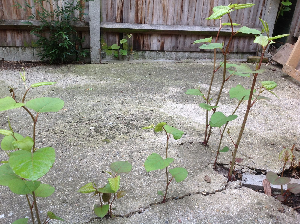What to do if Japanese knotweed comes up on a Home Buyers survey
By Charles Vickers, director of C and F (UK) Ltd – Knotweed specialist
 Japanese knotweed is a flowering plant that was first introduced to Britain from the Far East in the 19th century.
Japanese knotweed is a flowering plant that was first introduced to Britain from the Far East in the 19th century.
Back in Japan, its manifestation is kept in check by indigenous insects. But in the UK these insects don’t currently exist, meaning the knotweed is left to grow – up to 10cm a day, destroying things in its path… which is why having it near your property becomes a problem and complicates your sale.
It’s common too, with experts saying that there’s not a 6 square mile section of the UK that doesn’t contain the plant. The UK government estimate that the potential cost of trying to eradicate knotweed is £1.25 billion, in fact the cost of removing knotweed from the Olympic Park site before the 2012 Olympic Games came in at £70m.
We deal with Japanese Knotweed for commercial and domestic clients on a regular basis, so first things first, try not to panic, you’re not the only person facing this challenge. There are lots of contractors out there who are experts in the treatment of Japanese knotweed, qualified in offering advice to you as a potential buyer or seller. My top advice is for buyers and sellers is:
Choose a PCA approved contractor
The more common knotweed gets, the better lenders are getting at processing it. Mortgage lenders are happier to proceed with a PCA member contractor because these specialists have the ability to follow up the agreed work with a guarantee, meaning the risk to the lender is minimal. Our business is currently going through the PCA membership process because we are finding that more and more of our commercial clients need it to satisfy lenders, so I think your best bet to get things moving quickly is to stick with who the mortgage lenders feel comfortable with.
Give your contractor sight of the survey as soon as possible
If knotweed is flagged up on a survey, the buyers’ mortgage lender will typically ask for a specialist report to be commissioned at the expense of the seller. The report categorises the risk to the property on the RICS scale and detail how the knotweed will be treated. The buyer and lender will then make a decision on whether or not to proceed with the sale. Issues arise because the Home buyer’s survey tends to be carried out right at the end of the sale process, so any delay seems amplified.
Things start moving quickly immediately following the buyer’s survey, and anything flagged up like Japanese knotweed creates a big panic for all parties. It’s very useful for your contractor to have sight of the original survey report so we understand what the surveyor and mortgage lender have an issue with. It could be that is isn’t Japanese knotweed at all but a similar plant, or sometimes the homeowner has removed the evidence since the survey. Having the survey report will also detail the surveyors recommendations; eg. Property not suitable for mortgage purposes, suitable but with 100% retention subject to Japanese knotweed contract, or Japanese knotweed must be removed or eradicated prior to exchange. Having sight of the survey will give your contractor the means to start addressing the issues straight away and helping you on the road to exchange faster.
And another thing…
Please leave the Japanese knotweed alone, the worst situation we encounter is bodged treatment work and can delay the treatment. Also, be prepared to leave the knotweed alone throughout the treatment programme, there is a lot that can be done to accommodate normal use of a garden but if the new occupier disturbs/digs/treats/paves over the knotweed and the programme can’t be completed then the warranty will be invalid.


